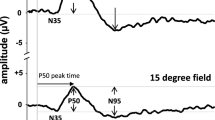Abstract
We recorded pattern electroretinograms and visual evoked potentials in a group of selected patients with unilateral uncomplicated branch retinal vein occlusion. To document the effects of preexisting risk factors, patients were divided into three groups: diabetes mellitus, hypertension with hyperlipidemia and no systemic disease. The transient and steady-state pattern electroretinogram and visual evoked potential amplitudes were significantly reduced and visual evoked potential peak times were delayed relative to the fellow eyes and agematched normal subjects. There was a second amplitude reduction relative to the other patient groups in both the affected and fellow eyes of the diabetes mellitus group, which was indicative of an additive effect of diabetes mellitus.
Similar content being viewed by others
Abbreviations
- BRVO:
-
branch retinal vein occlusion
References
Clarkson JB. Central retinal vein occlusion.In: Ryan SJ, ed. Retina. St. Louis: Mosby, 1989: 421–6.
Finkelstein D. Laser treatment of branch and central retinal vein occlusion. Int Ophthalmol Clin 1990; 30: 84–8.
Finkelstein D, Clarkson JB, Branch Vein Occlusion Group. Branch and central vein occlusions. Focal points, 1987: San Francisco: American Academy of Ophthalmology, Clinical modules for ophthalmologists 5 (module 12): No. 3.
Atmaca LS. Traitement par photocoagulation des occlusions de la veine centrale de la retine. Bull Soc Ophthalmol 1985; 85: 357–60.
Finkelstein D. Retinal branch vein occlusion.In: Ryan SJ, ed. Retina. St. Louis: Mosby, 1989; 2: 427–32.
Hayreh SS, Klugman MR, Podhajsky P, Kolder HE. Electroretinography in central vein occlusion: correlation of electroretinographic changes with pupillary abnormalities. Graefes Arch Clin Exp Ophthalmol 1989; 227: 549–61.
Matsui Y, Katsumi O, McMeel JW, Hirose T. Prognostic value of electroretinogram (ERG) in central retinal vein obstruction (CRVO). Invest Ophthalmol Vis Sci 1991; 32(suppl.): 1227.
Sokol S, Jones K, Nadler D. Comparison of the spatial response properties of the human retina and cortex as measured by simultaneously recorded pattern ERG and VEPs. Vision Res 1983; 23: 723–7.
Hess, RF, Baker CL. Human pattern-evoked electroretinogram. J Neurophysiol 1984; 51: 939–51.
Arden GB, Vaegan. Electroretinograms evoked in man by local uniform or pattern stimulation. J Physiol 1983; 341: 85–104.
Orth DH, Patz A. Retinal branch vein occlusion. Surv Ophthalmol 1978; 22: 357–76.
Sekimoto M, Hayasaka S, Setogawa T. Type of arteriovenous crossing at site of branch retinal vein occlusion. Jpn J Ophthalmol 1992; 36: 192–6.
The Eye Disease Case-Control Study Group. Risk factors for branch retinal vein occlusion. Am J Ophthalmol 1993; 116: 286–96.
Tewari HK, Khosla A, Khosla PK, Kumar A. Bilateral branch vein occlusion. Acta Ophthalmol 1992; 70: 278–80.
Appiah AP, Trempe CL. Risk factors associated with branch vs. central vein occlusion. Ann Ophthalmol 1989; 21: 153–5.
Dodson PM, Galton DJ, Winder AF. Retinal vascular abnormalities in the hyperlipi-daemias. Trans Ophthalmol Soc U K 1981; 101: 17–22.
Dodson PM, Galton DJ, Hamilton AM, Black RK. Retinal vein occlusion and the prevalence of lipoprotein abnormalities. Br J Ophthalmol 1982; 66: 161–4.
Dodson PM, Westwick J, Marks G, Kakkar VV, Galton DJ. Beta-thromboglobulin and platelet factor levels in retinal vein occlusion. Br J Ophthalmol 1983; 67: 143–6.
Pollock A, Dottan S, Oliver M. The fellow eye in retinal vein occlusive disease. Ophthalmology 1989; 96: 842–5.
Teoh SL, Amarjeet K. A comparative study of branch retinal vein occlusion and central vein occlusion amongst Malaysian patients. Med J Malaysia 1993; 48: 410–5.
Bertel PR, Vos A. Induced refractive errors and pattern electroretinograms and pattern visual evoked potentials: implications for clinical assessments. Electroencephalogr Clin Neurophysiol 1994; 92: 78–81.
Tomoda H, Celesia GG, Brigell MG, Toleikis S. The effects of age on steady-state pattern electroretinograms and visual evoked potentials. Doc Ophthalmol 1991; 77: 201–11.
Arden GB, Carter RM, MacFarlan A. Pattern and ganzfeld electroretinograms in macular disease. Br J Ophthalmol 1984; 68: 878–84.
Vaegan, Arden GB, Hogg CR. Properties of normal electroretinograms evoked by pattern stimuli in man: abnormalities in optic nerve disease and amblyopia. Doc Ophthalmol Proc Ser 1982; 31: 111–29.
Arden GB, Hamilton AMP, Wilson-Holt J, Ryan S, Yudkin JS, Kurtz A. Pattern electroretinograms become abnormal when background diabetic retinopathy deteriorates to a preproliferative stage: possible use as a screening test. Br J Ophthalmol 1986; 70: 330–5.
Falcini B, Porciatti V, Scalia G, Caputo S, Minnella A, DiLeo MA, Ghirlanda G. Steady-state pattern electroretinogram in insulin-dependent diabetics with no or minimal retinopathy. Doc Ophthalmol 1989; 73: 193–200.
Parisi V, Uccioli L, Monticone G, Parisi L, Menzinger G, Bucci MG. Visual evoked potentials after photostress in insulin-dependent diabetic patients with or without retinopathy. Graefes Arch Clin Exp Ophthalmol 1994; 232: 193–8.
Berninger TA, Arden GB. The pattern electroretinogram. Eye 1988; 2(suppl.): 257–83.
Tetsuka S, Katsumi O, Mehta M, Tetsuka H, Hirose T. Effect of stimulus contrast on simultaneous steady-state pattern reversal electroretinogram and visual evoked response. Ophthalmic Res 1992; 24: 110–8.
Author information
Authors and Affiliations
Rights and permissions
About this article
Cite this article
Gündüz, K., Zengİn, N., Okudan, S. et al. Pattern-reversal electroretinograms and visual evoked potentials in branch retinal vein occlusion. Doc Ophthalmol 91, 155–164 (1995). https://doi.org/10.1007/BF01203695
Accepted:
Issue Date:
DOI: https://doi.org/10.1007/BF01203695




